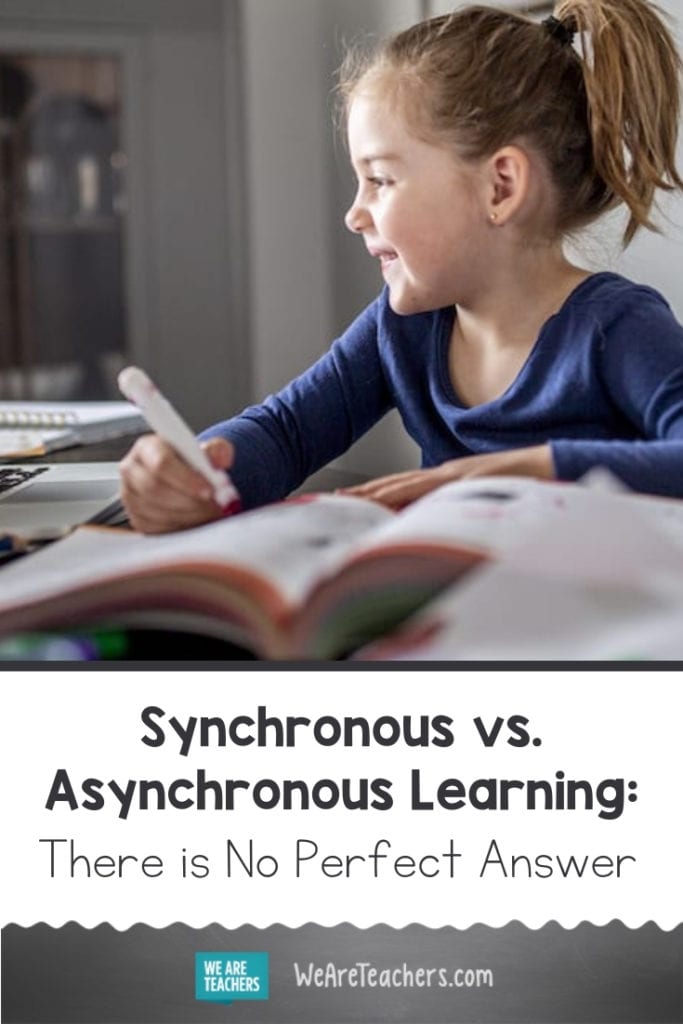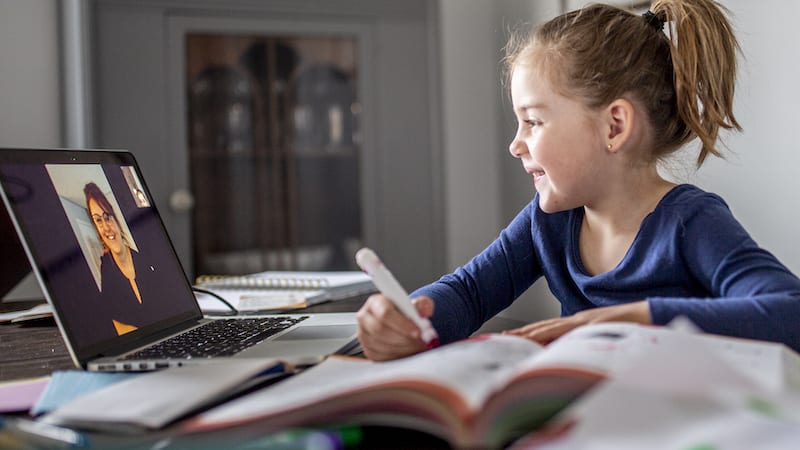One of the biggest debates we’ve seen since remote learning started is how much time kids should spend doing synchronous vs. asynchronous work. Schools need to find a blend of both learning types that works for their population and needs. There is no magic formula or perfect balance. What’s most important is providing flexibility and equity for students and their caregivers. We looked to education experts to answer some of our most pressing questions given the level and scale of what teachers can try and implement this school year.
1. One size doesn’t fit all
If there is no formula or perfect balance, how do we decide what subjects and for how long the students should learn synchronously or asynchronously? Bonnie Cochran, Director of Academic Planning and Analytics at Houghton Mifflin Harcourt, suggests that we consider a range of factors.
“When we think about trying to strike a balance, we need to consider our students’ ages, how skilled they are with technology, the complexity level of the task that we are putting in front of them, and the amount of support they have at home.”
Some of these factors we will know right away (hey there, fellow middle school teachers!). Other factors we will learn through observation and student and caretaker feedback. When in doubt, trust your “teacher gut.” Be patient and kind to yourself. Know that this is a school year unlike any other. Experimentation, trial and error, and collaboration with colleagues are especially important to find the mix that works best for you and your students.
2. Relationships are built in small groups
We know that our relationships with students and their connections with each other set a strong foundation for learning. This is why we prioritize building classroom community during the first weeks of school. How can we provide opportunities for students to get to know us and each other online? Is this done best synchronously or asynchronously?
Lisa Bush, Vice President of Math Solutions Professional Services at HMH, reminds us that relationships are rarely developed in a whole group setting. “If you took a larger group, you see smaller groups form within that larger group,” she says. “Get a couple of kids connecting online in small groups, and then mix those groups thoughtfully and intentionally over time.”
While it may take more time, Bush believes that taking the time to connect with students 1:1 is important. She recommends connecting students in small groups. This will help form deeper and lasting relationships and is best done synchronously.
3. Established relationships can thrive asynchronously
We know that students are engaged in the learning process when they have opportunities to discuss and share ideas and knowledge with their peers. We have to remember that many of our students rely on asynchronous communication to socialize with their friends (texting, social media, etc.). Use tools like Flipgrid, Padlet,and Voxer so older students can learn and connect together. For younger kids, we love Kidblog and Seesaw.
4. New skills and content are best flipped
Whenever we introduce a new topic or skill, we scan our students’ faces for visual clues that tell us if we need to slow down, speed up, or check in. How can we be sure that students are learning new material if we aren’t in the classroom? Sharing a video lesson with students is an effective way to introduce new material online. Students can slow down, speed up, or pause the video, and they can rewatch it. Then you can have class discussions about the presented material during synchronous learning.
5. Assessment is a teaching act
Speaking of assessment, there is no shortage of technology tools for assessing students’ learning (we love Socrative, Google and Microsoft forms, and EdPuzzle). We need access to student data so we can use it to strategically group students, identify learning gaps, and plan our next instructional moves. However, a tool will not replace hearing what students are saying, seeing their body language, and observing firsthand how they grapple with a task in real-time. Bush suggests that assessing is a teaching act. She recommends assessing students synchronously and asking them to produce something for you that demonstrates their learning.
6. Unplugged learning is part of the plan
There is no question that we need to get creative about incorporating screen breaks and movement in our kids’ online learning schedules. “Students need to step away from a screen. There are a lot of things that we can do to help students turn off the screen and engage physically with their learning,” Bush says. Kids can practice math with scrap paper and a pencil. They can curl up with a book or read with a caretaker or sibling. Unplugged learning might involve going outside, using materials around the house to engage in design thinking or experimentation, making art, etc.
7. Create a cadence for learning
To make the planning process less daunting, break it down by task (what will students do?), time (how much time will they spend?), and tools (what will they use?). Depending on how you like to plan, imagine what an average day of online learning might look like for your kids. Consider these questions:
- When are kids learning in real time?
- When are kids learning on their own?
- What routines will happen regularly in your online classroom?
- How will students collaborate in real time?
- When will students collaborate asynchronously?
- What pace of learning will you expect?
- How and when will students set goals and reflect on their learning and learning experience?
- How will you assess students and provide feedback?
Set a schedule that you believe will work best for you and your students. Find balance, and be consistent. Don’t be afraid to make changes, especially if those changes are in response to data and student and caregiver feedback.
8. A flexible schedule is the only schedule
Schools typically run on a set schedule. Planning in a brick and mortar classroom relies heavily on how much time we have (are class periods 50 minutes or an hour?). Also, the resources we have (all students have a computer and equal access to the internet). This year we cannot approach our teaching through the same lens. One family may have one computer for three children. Another family might not have access to the internet. Students are learning at home. Families need flexibility. The schedule will be different than what we are used to.
9. It will take a village
This year will bring new challenges, but also opportunities. Because there is such a steep learning curve, it is important that we lean on our colleagues. Strong relationships are more important than ever. Learn what other teachers are doing and what their mix of synchronous and asynchronous learning is. See out professional development and opportunities to learn. This 20 minute webinar: Distance Learning in Today’s World: What Do I Do Now? from HMH is a great place to start. Ask for help when you need it, and don’t be afraid to step outside your comfort zone. The best professional development is the teacher down the hall (or the teacher you connect with on social media!). Stay connected. You’ve got this!
What are your tips for balancing synchronous vs. asynchronous learning? Share in the comments below.



